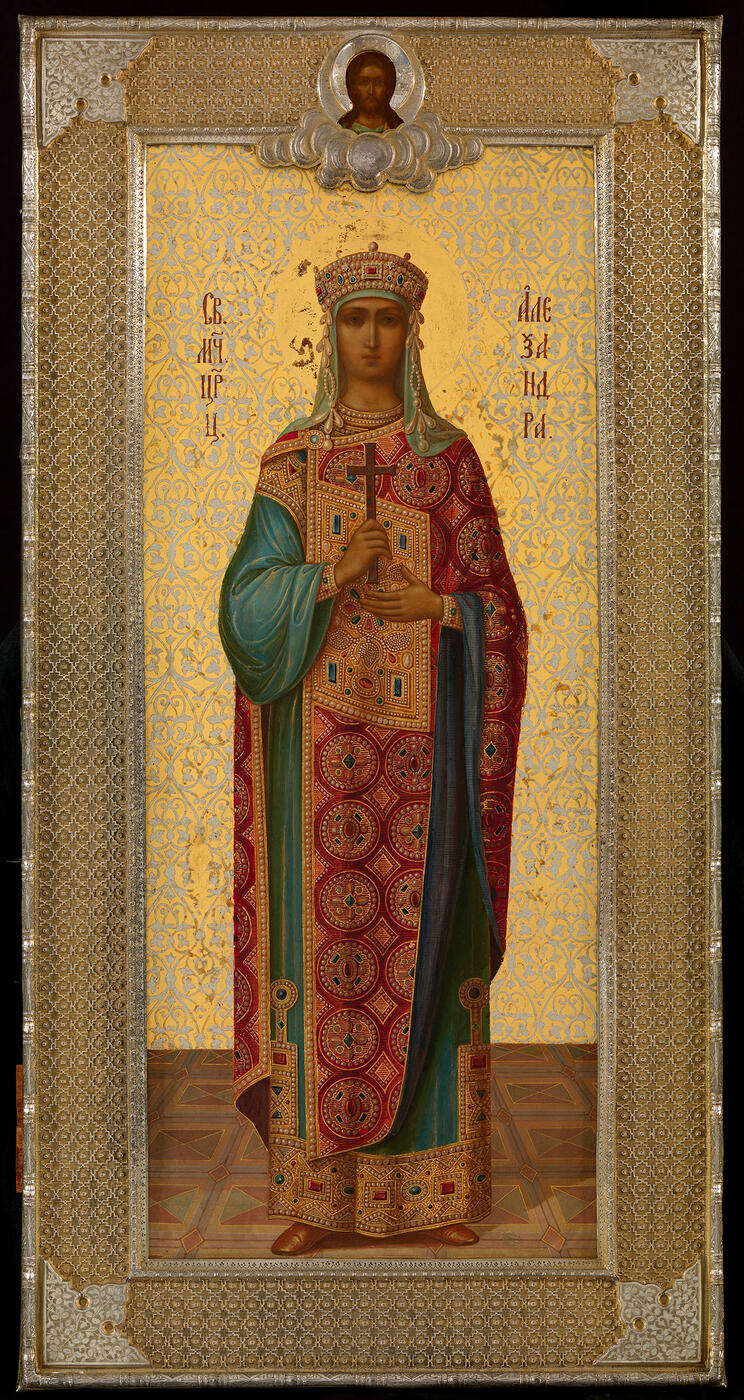MacDougall's Russian Art Auctions 27-30 May 2012
27 May 2012

* 421. ST ALEXANDRA, THE EMPRESS, IN A SILVER-GILT OKLAD
OIL AND TEMPERA ON PANEL, OKLAD STAMPED WITH MARK OF PAVEL OVCHINNIKOV IN CYRILLIC UNDER IMPERIAL WARRANT, MOSCOW, 1883, 84 STANDARD .
52 by 26.5 cm.
38,000–50,000 GBP
This valuable commissioned icon depicts St. Alexandra (commemorated
on 23rd April), wife of the Emperor Diocletian (or according to some sources, widow of one of his predecessors), who suffered together with the Great Martyr St. George, the Bringer of Victory, during the persecutions of Christians at the beginning of the 4th century. In the 19th century, this royal martyr was
regarded a s the Protectress of Russian Empresses, which explains the popularity of her icons at that time, as opposed to previous centuries. The Empresses Alexandra Fyodorovna (1798–1860), wife of Nicholas I, and Alexandra Fyodorovna (1872–1918), wife of Nicholas II, both received the name Alexandra in honour of this saint upon their conversion to Orthodoxy. In the 1830s–1860s and 1890s, there were churches and chapels consecrated to the
Blessed Tsarina Alexandra in both Moscow and St. Petersburg.
The 1883 date on the oklad links the icon to the events of the Coronation of Emperor Alexander III and Empress Maria Fyodorovna on the 15th May 1883 at the Cathedral of the Dormition in the Moscow Kremlin, two years after Alexander III’s
accession to the throne. A thanksgiving offering could be made to the church by those honoured with the monarch’s favour, and also by those who had taken part in the Coronation ceremonies (these cases are well known). The slightly larger dimensions of the icon indicate that it was intended for a church, rather than a domestic setting. It is also entirely possible that another icon was commissioned to go with it, depicting the princely saint Alexander
Nevsky, Protector of Russian Emperors and patron to Emperor’s ascending the throne.
The icon, with its highly professional quality of production,
is a brilliant example of icon-painting from this revivalist era. The saint’s apparel is richly decorated and painted in great detail with gemstones and pearls at the neck and hem of the embroidered tunic. The precious cloak is further enriched with a jewelled breast-piece, the headdress has grand additional ornamentation, all of which are rendered in the traditions of “archaeological painting”,
a genre founded by the eminent Russian graphic artist, Fyodor Grigoryevich Solntsev (1801–1892). The portrayal of the Tsarina Alexandra is surprisingly reminiscent of the drawings he made of the frescoes in St. Sophia’s Cathedral in Kiev and the manuscript miniatures from the collections of the Princes
Obolensky and Gagarin, as recorded in Ancient Depictions, Portraits
and Dress of Grand Princes, Tsars, Boyars and Common Folk (Antiquities of
the Russian State, Moscow, 1851, Section 4, Fig. 4–18). The richness
of the saint’s apparel is echoed in the silver foliate ornamentation on the gilded background and the silver oklad, seemingly studded with fine stones, which was made in the workshop of the court jeweller, Pavel Akimovich Ovchinnikov.
This icon of Saint Tsarina Alexandra makes an important contribution to the appraisal of Russian icon-painting and the life of the church community in Russia in the last quarter of the 19th century.
Notes on symbols:
* Indicates 5% Import Duty Charge applies.
Ω Indicates 20% Import Duty Charge applies.
§ Indicates Artist's Resale Right applies.
† Indicates Standard VAT scheme applies, and the rate of 20% VAT will be charged on both hammer price and premium.